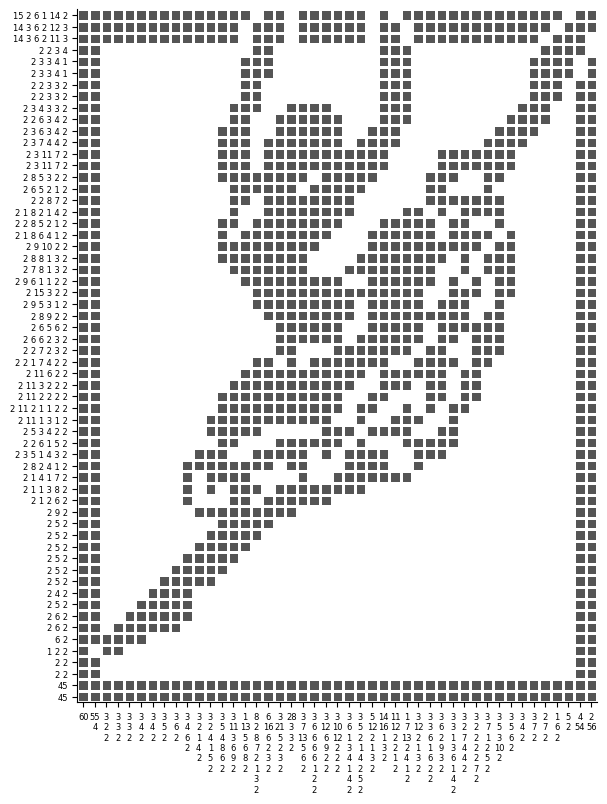ノノグラムゲーム#
前章では、pysat を使用したノノグラムの解き方について説明しました。本章では、CP-SAT を用いた解法を紹介します。CP-SAT では整数変数を扱うことができ、制約条件をより簡単に表現できます。
See also
from ortools.sat.python import cp_model
from helper.ortools import get_all_solutions
load C:\mamba\envs\py312\Lib\site-packages\ortools\.libs\zlib1.dll...
load C:\mamba\envs\py312\Lib\site-packages\ortools\.libs\abseil_dll.dll...
load C:\mamba\envs\py312\Lib\site-packages\ortools\.libs\utf8_validity.dll...
load C:\mamba\envs\py312\Lib\site-packages\ortools\.libs\re2.dll...
load C:\mamba\envs\py312\Lib\site-packages\ortools\.libs\libprotobuf.dll...
load C:\mamba\envs\py312\Lib\site-packages\ortools\.libs\highs.dll...
load C:\mamba\envs\py312\Lib\site-packages\ortools\.libs\ortools.dll...
開始インデックスの制約条件#
まず、一組の数字を考えます。それぞれの数字に対応する開始インデックスを算出できれば、マスを塗りつぶすことができます。次の place_numbers() 関数では、各数字に対応するインデックスの制約条件を追加します。
locationsは各数字の開始位置を表す変数のリストです。制約
model.add(n2 > n1 + c)により、各数字ブロックが適切に配置されることを保証します(cは前の数字の長さ)。最後の制約
model.add(locations[-1] <= width - numbers[-1])は、最後のブロックが範囲を超えないようにします。
import string
def place_numbers(model, numbers, width, prefix=""):
locations = [model.new_int_var(0, width - 1, f"{prefix}{name}") for _, name in zip(numbers, string.ascii_uppercase)]
for n1, n2, c in zip(locations[:-1], locations[1:], numbers):
model.add(n2 > n1 + c)
model.add(locations[-1] <= width - numbers[-1])
return locations
def show_all_locations(numbers, width):
model = cp_model.CpModel()
locations = place_numbers(model, numbers, width)
return get_all_solutions(model)
次に、5マスのグリッドに対して、数字2と1でマスを塗りつぶす場合のすべての解を求めます。
show_all_locations([2, 1], 5)
[{'A': 0, 'B': 3}, {'A': 0, 'B': 4}, {'A': 1, 'B': 4}]
次に、10マスのグリッドに対して、数字3、2、2でマスを塗りつぶす場合のすべての解を求めます。
show_all_locations([3, 2, 2], 10)
[{'A': 0, 'B': 4, 'C': 7},
{'A': 0, 'B': 4, 'C': 8},
{'A': 0, 'B': 5, 'C': 8},
{'A': 1, 'B': 5, 'C': 8}]
マスの充填#
次のグラフのように、開始インデックスと長さを基にして、一行のパターンを作成します。グラフでは、一つ目の数字の開始位置が 0 で長さが 2、二つ目の数字の開始位置が 3 で長さが 1 の場合を示しています。最終的なパターン Targets を算出するために、各数字ごとに A Fill および B Fill のパターンを作成し、それらをマスごとに論理和(OR演算)を取ることで Targets を求めます。
graph LR
subgraph C_fill["Targets"]
direction LR
c0[1]
c1[1]
c2[0]
c3[1]
c4[0]
c0 ~~~ c1
c1 ~~~ c2
c2 ~~~ c3
c3 ~~~ c4
end
subgraph A_fill["A Fill"]
direction LR
a0[1]
a1[1]
a2[0]
a3[0]
a4[0]
a0 ~~~ a1
a1 ~~~ a2
a2 ~~~ a3
a3 ~~~ a4
end
subgraph B_fill["B Fill"]
direction LR
b0[0]
b1[0]
b2[0]
b3[1]
b4[0]
b0 ~~~ b1
b1 ~~~ b2
b2 ~~~ b3
b3 ~~~ b4
end
A["A=0 (n=2)"]
B["B=3 (n=1)"]
A --> A_fill
B --> B_fill
A_fill --> C_fill
B_fill --> C_fill
次の fill_pattern() 関数は、numbers の各数字を使用して、ブール変数のリスト targets を塗りつぶします。このロジックを Python コードで表すと、以下のようになります。
if A == 0:
A_fill = [1, 1, 0, 0, 0]
elif A == 1:
A_fill = [0, 1, 1, 0, 0]
...
しかし、CP-SAT では比較式を直接制約条件の前提条件として使用できません。そのため、別のブール変数 b を作成し、次のような制約を追加して b と n == i が一致するようにします。
model.add(n == i).only_enforce_if(b)
model.add(n != i).only_enforce_if(~b)
最後に、targets[i] の状態に応じて fills 内のブール変数を制約します。
targets[i]がTrueの場合、同じインデックスに対応するfillsのブール変数のうち、少なくとも一つがTrueである必要があります。targets[i]がFalseの場合、対応するfillsのブール変数はすべてFalseでなければなりません。
この論理は、以下のように CP-SAT の制約として表現できます。
model.add_bool_or(bools).only_enforce_if(t)
model.add_bool_and([~v for v in bools]).only_enforce_if(~t)
def fill_pattern(model, numbers, targets, prefix=""):
width = len(targets)
count = len(numbers)
locations = place_numbers(model, numbers, width, prefix)
fills = {}
for i in range(width):
for j in range(count):
fills[i, j] = model.new_bool_var(f'{locations[j].name}_{i}')
for j, n in enumerate(locations):
for i in range(width - numbers[j] + 1):
# b is equal to locations[j] == i
b = model.new_bool_var(f'{n.name}_{i}')
model.add(n == i).only_enforce_if(b)
model.add(n != i).only_enforce_if(~b)
# fill fills by b
tmp = [fills[x, j] if i <= x < i + numbers[j] else ~fills[x, j] for x in range(width)]
model.add_bool_and(tmp).only_enforce_if(b)
for i, t in enumerate(targets):
bools = [fills[i, j] for j in range(count)]
# if target is True then fills[i, *] must have one True
model.add_bool_or(bools).only_enforce_if(t)
# if target is False then all fills[i, *] must be False
model.add_bool_and([~v for v in bools]).only_enforce_if(~t)
def show_all_fills(numbers, width):
model = cp_model.CpModel()
targets = [model.new_bool_var(f"{i}") for i in range(width)]
fill_pattern(model, numbers, targets)
for sol in get_all_solutions(model):
print([sol[t.name] for t in targets])
次はfill_pattern()をテストします。
show_all_fills([2, 1], 5)
[1, 1, 0, 0, 1]
[1, 1, 0, 1, 0]
[0, 1, 1, 0, 1]
show_all_fills([3, 2, 2], 10)
[1, 1, 1, 0, 1, 1, 0, 0, 1, 1]
[1, 1, 1, 0, 0, 1, 1, 0, 1, 1]
[1, 1, 1, 0, 1, 1, 0, 1, 1, 0]
[0, 1, 1, 1, 0, 1, 1, 0, 1, 1]
ノノグラムを解く#
次のコードでは、グリッドの各マスに対応するブール変数を作成し、行と列の数字に基づいて fill_pattern() を適用することで、それぞれのマスを埋めます。これにより、ノノグラムを解くことができます。
def solve_nonogram(rows, cols):
model = cp_model.CpModel()
width = len(cols)
height = len(rows)
cells = [[model.new_bool_var(f"T_{r}_{c}") for c in range(width)] for r in range(height)]
for r, numbers in enumerate(rows):
line = cells[r]
fill_pattern(model, numbers, line, f"R{r}")
for c, numbers in enumerate(cols):
line = [cells[i][c] for i in range(height)]
fill_pattern(model, numbers, line, f"C{c}")
solver = cp_model.CpSolver()
solver.solve(model)
return [[solver.value(c) for c in row] for row in cells]
次は、最も難しいパズルに挑戦してみましょう。
%%time
import json
with open(r"data\nonogram03.json") as f:
puzzle = json.load(f)
result = solve_nonogram(**puzzle)
CPU times: total: 23.9 s
Wall time: 24.8 s
from helper.plot import plot_nonogram_board
plot_nonogram_board(puzzle, result, font_size=6);
